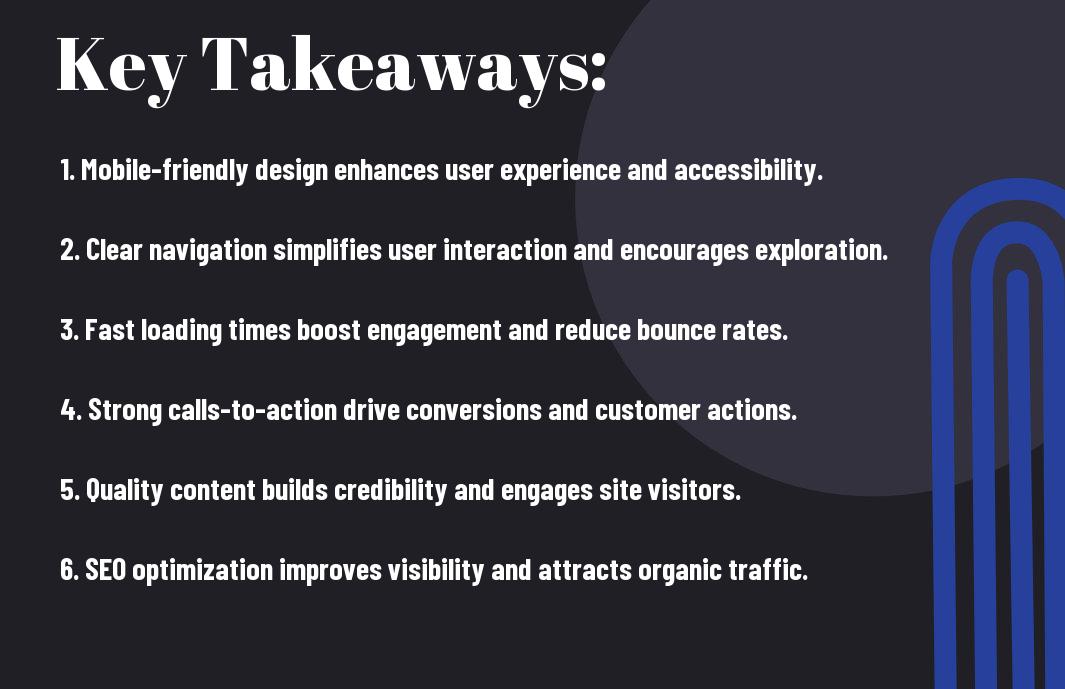You want your small business website to stand out and drive significant growth. To achieve this, it must have features that enhance user experience and optimize for search engines. Incorporating a mobile-responsive design ensures that visitors can navigate easily on any device, while fast loading times keep potential customers engaged. A clear call-to-action and integrated SEO strategies can be game-changers, ultimately leading to increased conversions and sales. Understanding these vital features will put you on the right path to achieving immense success online.
Key Takeaways:
- A user-friendly design that ensures easy navigation is important for keeping visitors engaged and encouraging them to explore more of the website’s offerings.
- Mobile optimization is critical, as a significant portion of users access websites from smartphones; a responsive design enhances user experience across all devices.
- Incorporating clear calls to action (CTAs) helps guide visitors towards desired actions, such as making a purchase or signing up for a newsletter, ultimately driving conversions.

Importance of Professional Design
The role of professional design in your website cannot be overstated. A well-crafted design not only enhances your brand’s image but also instills trust in potential customers. When your website looks polished and user-friendly, it reflects the quality of your products or services and invites visitors to explore further, ultimately leading to increased engagement and conversions.
First Impressions Matter
An engaging first impression can determine whether a visitor stays on your site or navigates away. Your website often serves as the first point of contact between you and your potential customers. A professional design can capture your audience’s attention, convey your brand message, and encourage them to probe deeper into what you offer.
User Experience and Navigation
For an effective website, user experience and navigation are key elements that directly influence how visitors interact with your content. A slick, intuitive design helps users easily find information, streamlining their journey from landing on your site to converting into customers.
Another aspect of user experience is the efficiency of your navigation structure. When visitors can effortlessly locate what they need, it leads to a more satisfying experience. Ensure your menu is straightforward and your pages load quickly, as slow loading times can frustrate users and drive them away. Additionally, consider the layout of your content; visually appealing elements mixed with coherent organization not only keeps visitors engaged but also encourages them to explore further, ultimately enhancing the overall success of your small business.
Mobile Responsiveness
Clearly, a mobile-responsive website is important for small business success in today’s digital age. With an increasing number of users accessing the web via smartphones, ensuring that your site adapts seamlessly to varying screen sizes not only enhances user experience but also increases engagement. A responsive design can lead to higher customer retention rates, turning casual visitors into loyal clients.
Catering to Mobile Users
About 50% of global web traffic now comes from mobile devices, making it important for your website to cater to this audience. A mobile-optimized site ensures easier navigation, faster load times, and a simplified checkout process, ultimately helping you meet your customers’ needs efficiently. By prioritizing mobile usage, you always make a significant impact on user satisfaction and retention.
Impact on SEO
Above all, mobile responsiveness plays a vital role in your search engine optimization (SEO) strategy. Google considers mobile-friendliness a ranking factor, meaning that if your site isn’t optimized for mobile, you risk dropping in search results. This could lead to a decrease in organic traffic, potentially harming your visibility and sales.
Impact on your SEO cannot be overstated. If your website fails to perform well on mobile devices, you may see a drop in rankings on search engines. This is because search engines like Google prioritize mobile-friendly designs, and an unresponsive site can lead to an increase in bounce rates as users abandon it for competitors. Additionally, a positive mobile experience can enhance user engagement and lead to improved conversion rates, positively influencing your overall site performance and visibility.
High-Quality Content
After creating a visually appealing website, high-quality content becomes crucial for attracting and retaining customers. Your audience seeks valuable information that addresses their needs and interests, driving engagement and fostering trust in your brand. By prioritizing well-researched, insightful, and original content, you position yourself as an authority in your niche and enhance your small business’s success.
Value in Information
Around your niche, providing valuable information is the backbone of high-quality content. By offering useful tips, industry insights, and solutions to common problems, you not only engage visitors but also establish credibility. Value-driven content positions your business as a trusted source, encouraging repeat visits and improving your website’s ranking in search engine results.
Engaging Your Audience
For a website to stand out, engaging your audience is fundamental. You want your visitors to connect with your content on a personal level, making them feel involved and valued. This can be achieved through storytelling, interactive elements, and inviting feedback. When you create a sense of community, your audience is more likely to return and recommend your site to others.
A strong engagement strategy helps to create a loyal customer base. You can accomplish this by using personalized content that resonates with your target audience. Implementing interactive features, such as quizzes, polls, or comment sections, encourages your visitors to interact with your site actively. When you respond to comments and feedback, it shows that you value their opinions, fostering a deeper connection. Ultimately, a well-engaged audience is more likely to convert into loyal customers, significantly impacting your small business’s growth and success.
Search Engine Optimization (SEO)
Unlike traditional marketing strategies, Search Engine Optimization (SEO) offers small businesses a way to enhance their online presence and engage with potential customers. By optimizing your website for search engines, you can improve visibility, drive traffic, and ultimately boost sales. Understanding and implementing SEO best practices is necessary for your digital success, especially in a competitive market.
Visibility in Search Results
Above all, enhancing your website’s visibility in search results is paramount for attracting new customers. When your site ranks higher on search engine results pages (SERPs), it increases the chances of users discovering your business. With effective SEO strategies, you can position your brand right in front of those who are actively seeking your products or services.
Best Practices for Small Businesses
For small businesses, adopting best practices in SEO can lead to significant growth. Start with keyword research to identify terms your target audience is searching for, and incorporate these strategically throughout your website. Additionally, ensure your site is mobile-friendly and loads quickly, as these factors influence your rankings. Regularly updating your content will also signal to search engines that your pages are relevant.
Further, you should focus on creating high-quality content that provides value to your audience. This not only helps with search rankings but also keeps visitors engaged. Building backlinks from reputable sources is another necessary SEO tactic, as it enhances your site’s credibility. Don’t overlook the importance of local SEO if you serve a specific geographic area; optimizing for local search will connect you with nearby customers. By following these best practices, you can create a solid foundation for your website’s SEO, which can lead to increased visibility and success.
Integration of Social Media
Your website should seamlessly integrate social media channels, allowing visitors to connect with your brand on various platforms. This integration encourages sharing and visibility, making it easier for you to reach potential customers. By incorporating social buttons and feeds, you create an interactive experience that enhances your online presence, leading to increased traffic and potential conversions.
Building Brand Awareness
Media plays an vital role in elevating your brand’s visibility. By showcasing engaging content and promoting your social channels on your website, you can expand your reach and create lasting impressions. This strategy helps potential customers recognize and remember your brand, ultimately driving interest in your products or services.
Fostering Customer Engagement
The integration of social media into your website is not just about awareness; it’s also about building meaningful connections with your audience. When you provide avenues for customers to interact, such as comments, shares, and likes, you foster a sense of community around your brand. Engaging with customers helps instill loyalty and creates a space where feedback can flow, guiding improvements to your offerings and demonstrating that you value their opinions.
Building on this engagement strategy can further enhance your relationship with customers. By actively responding to comments and messages on social platforms, you show that you care about their experiences and opinions. This two-way communication initiates trust and encourages customers to return. Additionally, utilizing social media to promote exclusive offers or events can create excitement and buzz around your brand, resulting in higher engagement rates and fostering a loyal customer base.
E-commerce Capabilities
For small businesses, having strong e-commerce capabilities is vital for reaching wider audiences and increasing sales. A well-designed website empowers you to showcase your products and services effectively, enabling customers to shop from the comfort of their homes.
Selling Products and Services Online
An effective e-commerce platform allows you to sell your products and services online easily, providing a seamless experience for customers. This feature can significantly enhance your visibility and increase potential revenue streams.
Ease of Transaction for Customers
At the forefront of your e-commerce strategy should be the ease of transactions for customers. A streamlined checkout process is necessary to ensure that potential buyers do not abandon their carts due to frustration or complicated steps.
Customers appreciate a simple and efficient shopping experience. Implementing features such as one-click purchasing, multiple payment options, and an intuitive interface can drastically improve their experience. When transactions are smooth and quick, it boosts your customer’s confidence and encourages repeat business. Additionally, ensuring that your site is mobile-friendly caters to users on various devices, enhancing their overall satisfaction and making it easier for them to complete purchases.
Final Words
Hence, to create a website that exemplifies small business success, you need to focus on user experience, mobile responsiveness, and clear calls to action. Incorporating SEO best practices will enhance your online visibility, while engaging content will keep visitors returning. Personalization and social media integration can help you build a community around your brand, fostering loyalty and trust. By addressing these key features, you position your business for sustained growth and success in the digital landscape.
Q: What crucial design elements should be included in a small business website?
A: A small business website should incorporate a clean and responsive design that ensures it looks good on any device. Important elements include an intuitive navigation menu, clear calls to action (CTAs), and a visually appealing homepage that conveys the brand message effectively. Additionally, using high-quality images and ensuring that the text is legible can greatly enhance user experience. Features such as customer testimonials, an easy-to-access contact form, and links to social media can also contribute to higher engagement and trustworthiness.
Q: How important is content for the success of a small business website?
A: Quality content is fundamental for a small business website as it helps to establish authority and engage visitors. Compelling and informative content not only supports SEO efforts, making it easier for potential customers to find the website, but also provides value to the audience, encouraging them to return. Regularly updated blogs, informative product descriptions, and valuable resources or guides can help small businesses connect with their audience, fostering loyalty and conversion.
Q: What role do analytics play in optimizing a small business website?
A: Analytics are vital for optimizing a small business website as they provide insights into user behavior, traffic sources, and overall website performance. By analyzing data such as page views, bounce rates, and user demographics, business owners can identify which areas of the website are performing well and which need improvement. This information allows for informed decision-making regarding marketing strategies, content updates, and user experience enhancements, helping the business adapt to its audience’s needs effectively.







